-Dependent Chemosensory Functions Contribute to Courtship Behavior in
Insects utilize diverse families of ion channels to respond to environmental cues and control mating, feeding, and the response to threats. Although degenerin/epithelial sodium channels (DEG/ENaC) represent one of the largest families of ion channels in Drosophila melanogaster, the physiological functions of these proteins are still poorly understood. We found that the DEG/ENaC channel ppk23 is expressed in a subpopulation of sexually dimorphic gustatory-like chemosensory bristles that are distinct from those expressing feeding-related gustatory receptors. Disrupting ppk23 or inhibiting activity of ppk23-expressing neurons did not alter gustatory responses. Instead, blocking ppk23-positive neurons or mutating the ppk23 gene delayed the initiation and reduced the intensity of male courtship. Furthermore, mutations in ppk23 altered the behavioral response of males to the female-specific aphrodisiac pheromone 7(Z), 11(Z)-Heptacosadiene. Together, these data indicate that ppk23 and the cells expressing it play an important role in the peripheral sensory system that determines sexual behavior in Drosophila.
Published in the journal:
-Dependent Chemosensory Functions Contribute to Courtship Behavior in. PLoS Genet 8(3): e32767. doi:10.1371/journal.pgen.1002587
Category:
Research Article
doi:
https://doi.org/10.1371/journal.pgen.1002587
Summary
Insects utilize diverse families of ion channels to respond to environmental cues and control mating, feeding, and the response to threats. Although degenerin/epithelial sodium channels (DEG/ENaC) represent one of the largest families of ion channels in Drosophila melanogaster, the physiological functions of these proteins are still poorly understood. We found that the DEG/ENaC channel ppk23 is expressed in a subpopulation of sexually dimorphic gustatory-like chemosensory bristles that are distinct from those expressing feeding-related gustatory receptors. Disrupting ppk23 or inhibiting activity of ppk23-expressing neurons did not alter gustatory responses. Instead, blocking ppk23-positive neurons or mutating the ppk23 gene delayed the initiation and reduced the intensity of male courtship. Furthermore, mutations in ppk23 altered the behavioral response of males to the female-specific aphrodisiac pheromone 7(Z), 11(Z)-Heptacosadiene. Together, these data indicate that ppk23 and the cells expressing it play an important role in the peripheral sensory system that determines sexual behavior in Drosophila.
Introduction
Animals have evolved a variety of mechanisms to monitor their chemical environment and to guide their behavior, many of which involve ion channels. For example, in vertebrates and insects, several members of the Transient Receptor Potential (TRP) channel family act as chemosensors for noxious stimuli [1]. Furthermore, insect olfactory receptors likely function as ligand-gated ion channels [2], [3]. Recently, a novel family of variant glutamate ionotropic receptors was also identified to contribute to olfactory functions in Drosophila melanogaster [4]. This diversity of ion channels suggested that additional ion channels might also play important chemosensory roles.
Additional ion channels that could potentially contribute to chemosensory-driven behaviors are the degenerin/epithelial Na+ channels (DEG/ENaC) [5]. DEG/ENaC genes are animal specific and various subunits are expressed in both the peripheral and central nervous systems of invertebrates and vertebrates. DEG/ENaC channels are activated by diverse ligands including protons (acid-sensing ion channels) [5] and the peptide FMRFamide in Helix aspersa (FaNaCh channels) [6]. They also contribute to salt sensation [7], [8], mechanosensation [9], and nociception [10]. However, the ligands and physiological function of the majority of DEG/ENaC family members remain unknown.
The Drosophila genome encodes 31 DEG/ENaC proteins, called Pickpocket (ppk) channels [7]. This is a greater number of DEG/ENaC genes than for any other currently sequenced animal genome, including other insects such as the honey bee, which encodes only five DEG/ENaC subunits [11]. The observations that some DEG/ENaC channels function as receptors for extra-cellular signals and that some are expressed in chemosensory organs in Drosophila and other species [7], led us to hypothesize that multiple members of the DEG/ENaC family might contribute to chemosensory–driven behaviors in insects.
To test this hypothesis, we used a genetic approach and expression analyses to discover chemosensory specific DEG/ENaC subunits and their possible contributions to behaviors. We have identified pickpocket 23 (ppk23), a member of the DEG/ENaC family, as a gene that is enriched in gustatory sensory neurons that are part of the sex circuit in flies. We demonstrate that ppk23 and the cells expressing it play a role in normal male-female courtship behavior but not feeding.
Results
Identifying potential chemosensory DEG/ENaC channel transcripts
The Drosophila melanogaster Pox neuro (Poxn) mutation causes a developmental fate switch of adult chemosensory bristles into pure mechanosensory bristles [12], [13], [14]. We reasoned that comparing gene expression in the sensory-rich appendages of wild-type and Poxn adults would reveal novel genes involved in chemosensation. We primarily focused on members of the DEG/ENaC family, which in flies represents one of the largest ion channel families in the fly genome [7], [15]. We used real-time quantitative RT-PCR assays to determine whether the Poxn mutation altered the abundance of several DEG/ENaC and sensory TRP channel transcripts. We also examined the chemosensory-related gene CheB42a as a positive control (Figure 1A). Compared to the wild type, expression of ppk23 and ppk7 were markedly reduced in Poxn appendages, suggesting that the function of these genes is associated with chemosensory bristles. Several other DEG/ENaC subunits and several TRP channels showed a mildly increased expression in Poxn appendages suggesting that they may contribute to mechanosensation. lounge lizard (llz, also called ppk25), which has been shown to be associated with chemosensory functions [16], [17], [18], showed a very mild reduction in expression that was not statistically significant, likely due to the small sample size used in our screen. In contrast, the dramatic reduction in ppk23 expression in the Poxn genetic background, more than any of the other DEG/ENaC subunits we have looked at thus far, led to our current focus on the role of this specific channel in chemosensory functions. Consistently, northern blot analyses designed to detect all predicted ppk23 transcripts (See Figure S1A for probe design) showed that ppk23 expression was highly enriched in appendages (legs and wings) relative to heads or bodies of both males and females (Figure 1B). Real-time quantitative RT-PCR assays also confirmed these results (Figure S1B).
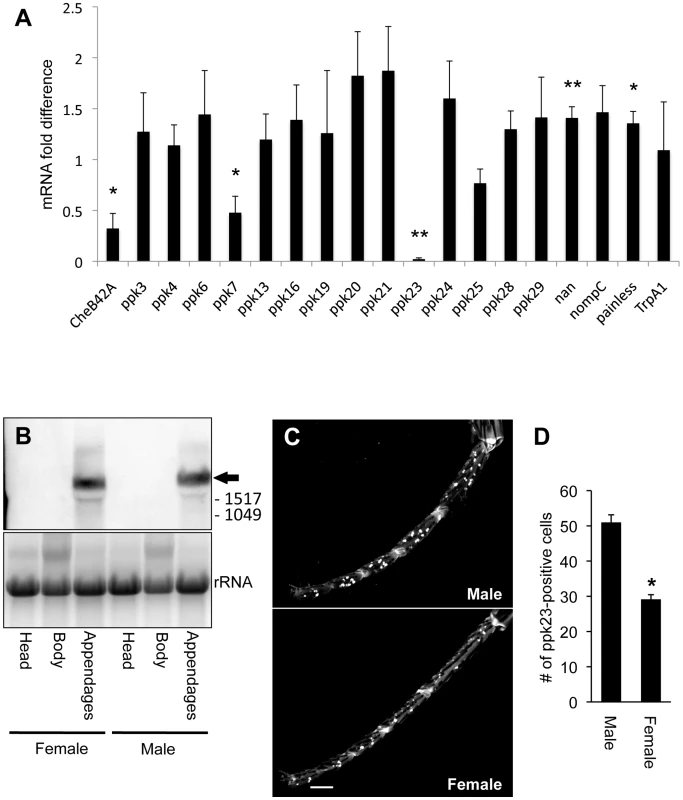
The ppk23 locus is on the X chromosome and predicted to produce three different transcripts from a single transcriptional start site (FlyBase.org; Figure S1A). A northern blot analysis identified only a single major transcript (Figure 1B). RT-PCR coupled with 5′ and 3′ RACE protocols identified this major transcript as a novel ppk23 transcript (ppk23-RX; NCBI accession number HM026485), (Figure S1A). The northern blot analysis also identified two minor bands. We currently do not know their identity, and whether they represent additional minor ppk23 transcripts or whether this is a non-specific signal. We also have identified an insertional hypomorphic allele of ppk23, which significantly reduced the expression of ppk23 in male appendages (Figure S1C).
To assess the spatial distribution of ppk23 expression, we used the ppk23 gene promoter linked to Gal4 to drive a UAS-nuclear GFP reporter in transgenic flies [19]. We found ppk23 expression enriched in adult appendages (Figure 1C, Figure S1D). When we expressed two copies of UAS-mCD8-GFP by two copies of ppk23 Gal4, a faint signal in few cells in the labellum was detected as well (data not shown), but not in any other sensory structures. We observed similar expression patterns of ppk23 in chemosensory neurons in three independent insertions of the same transgenic construct (data not shown). Expression of a nuclear GFP reporter in legs using the ppk23-GAL4 strain indicated that although the promoter was active in all legs (Figure S1D), expression in the forelegs of males showed significantly more ppk23-positive cells than females (Figure 1C and 1D). Since male forelegs play an important sensory role during courtship [20], these data suggested that the ppk23 locus might be playing a role in sexual behaviors in flies.
ppk23 is enriched in gustatory-like neurons
Higher resolution analyses of membrane-tethered GFP expression in the male foreleg and wing suggested that ppk23-positive cells are chemosensory neurons as evidenced by the projection of their cilium to the base of chemosensory bristles, which were identified by the lack of a bract and a thin, curved morphology [13], [21] (Figure 2A and 2B). We also found that the ppk23 promoter is active in pairs of sensory neurons with similar morphology that projected to single bristles (Figure 2A and 2B). Because chemosensory bristles contain at most one pure mechanosensitive neuron with distinct morphology [22], this further suggested that ppk23-positive neurons are chemosensory.
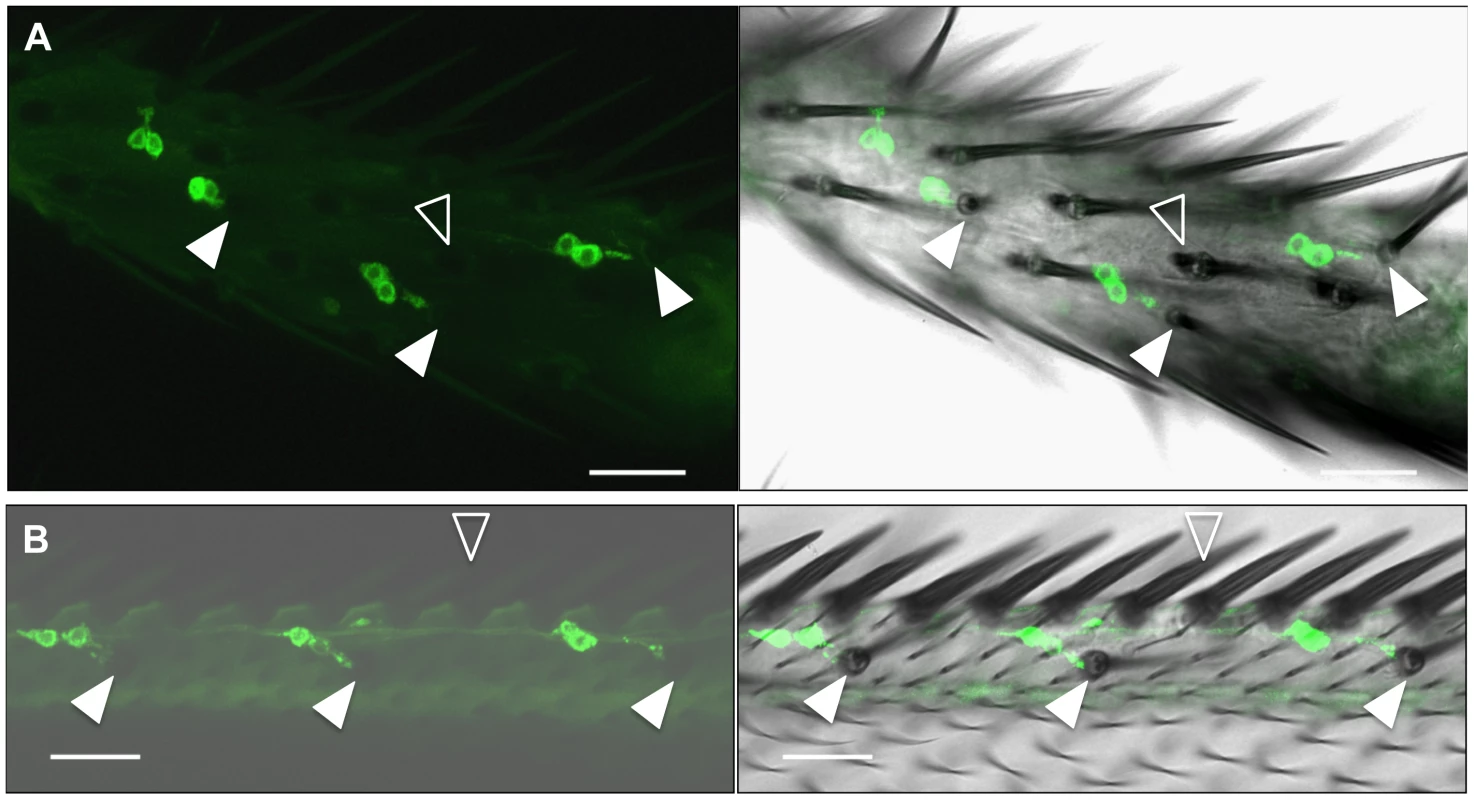
Projections of ppk23-positive neurons in the foreleg are sexually dimorphic and overlap with fru
The chemosensory system in flies plays an important role in regulating social behaviors such as courtship [23]. In addition, recent work indicated that at least some gustatory receptor neurons in fly appendages express the sex-determination gene fruitless (fru) [24], [25], and have sexually dimorphic axonal projection patterns to the CNS [26]. These data, in combination with the enrichment of ppk23-positive cells in the forelegs of males relative to females, led us to hypothesize that ppk23 and the cells expressing it might contribute to sex-related behaviors.
We first studied the axonal projection patterns of ppk23-positive neurons by expressing membrane-tethered GFP using a ppk23-GAL4 line and examined GFP patterns in the brain and the thoracic ganglion (Figure 3A and 3B). We did not observe ppk23-positive cell bodies in the brains or the thoracic ganglia of either males or females as evidenced by the lack of positive neuronal cell bodies. In contrast, we were able to clearly observe the axonal projection patterns of ppk23-positive sensory neurons in the thoracic ganglion as well as weak signal in the subesophageal ganglion. We could not resolve whether these axons represent a small population of labellar sensory neurons or extension of axons that originated in appendages. The axonal projection patterns of ppk23-positive sensory neurons from forelegs to the thoracic ganglion were sexually dimorphic, similar to the projections of male specific Poxn-positive gustatory neurons, which require fruM expression for their correct wiring (Figure 3C) [26]; ppk23-positive neurons originating in the male foreleg showed higher incidence of crossing the thoracic ganglion midline relative to females (Figure 3A and 3B respectively). The physiological significance of the midline crossing is still unknown.
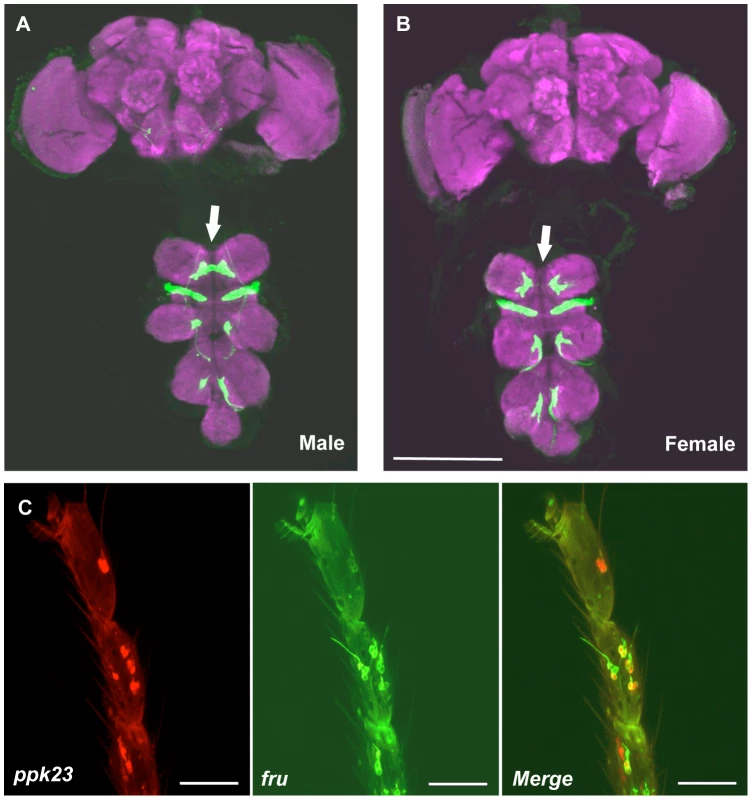
The possible overlap of ppk23 expression with the sex circuit was further supported by the co-localization of the ppk23 promoter with the fruP1 promoter, which is exclusively expressed in the sex circuit (Figure 3C) [24], [25], [26], [27], [28], [29]. Together, these data suggested that the gustatory sensory system includes a subpopulation of sensory neurons in forelegs that express both fru and ppk23 and is probably not involved in feeding-related taste functions [30].
ppk23-expressing cells play a role in normal male courtship behavior
The evidence that ppk23 expression is sexually dimorphic suggested the hypothesis that ppk23-expressing cells play a sensory role in courtship behavior. To test this hypothesis, we blocked neuronal activity in ppk23-expressing cells with ectopic expression of TNT using the UAS-GAL4 system. Inhibiting ppk23-expressing neurons increased the proportion of males that failed to demonstrate courtship behavior (Figure 4A). In males that did court, inhibiting ppk23-expressing neurons significantly delayed the initiation of courtship when males were exposed to wild-type virgin females (i.e., courtship latency increased, Figure 4B). The courtship index, which is the proportion of time males spent courting in 10 minutes, also fell (Figure 4C).
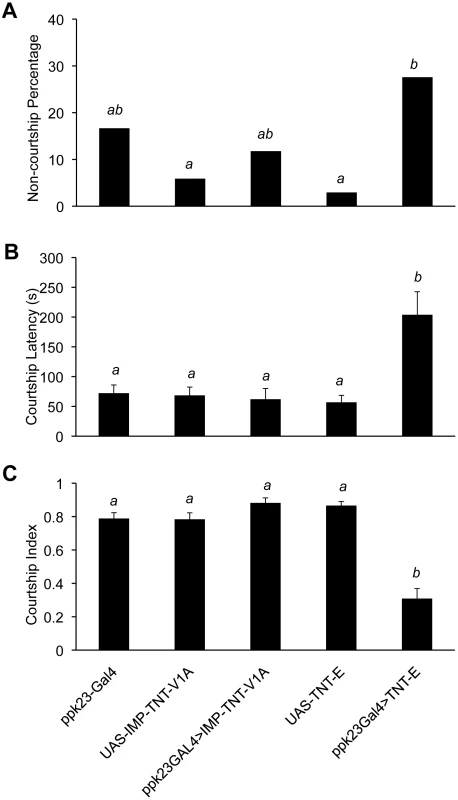
ppk23 contributes to normal male courtship
We also asked whether the ppk23 gene was important for normal courtship by utilizing the insetional hypomorphic allele ppk23PB (Figure S1A). Similarly to the TNT-blocking results, a high proportion of ppk23PB mutant males did not exhibit obvious courtship behaviors in 10 minutes (Figure 5A). The ppk23PB mutant males that did court had significantly longer courtship latency and a reduced courtship index towards wild-type mature females (Figure 5B, 5C). The effects of the ppk23 mutation on male courtship were specific to male-female interactions since we did not observe statistically significant effects of the mutations on naturally occurring male-male courtship interactions (Figure 5A–5C).
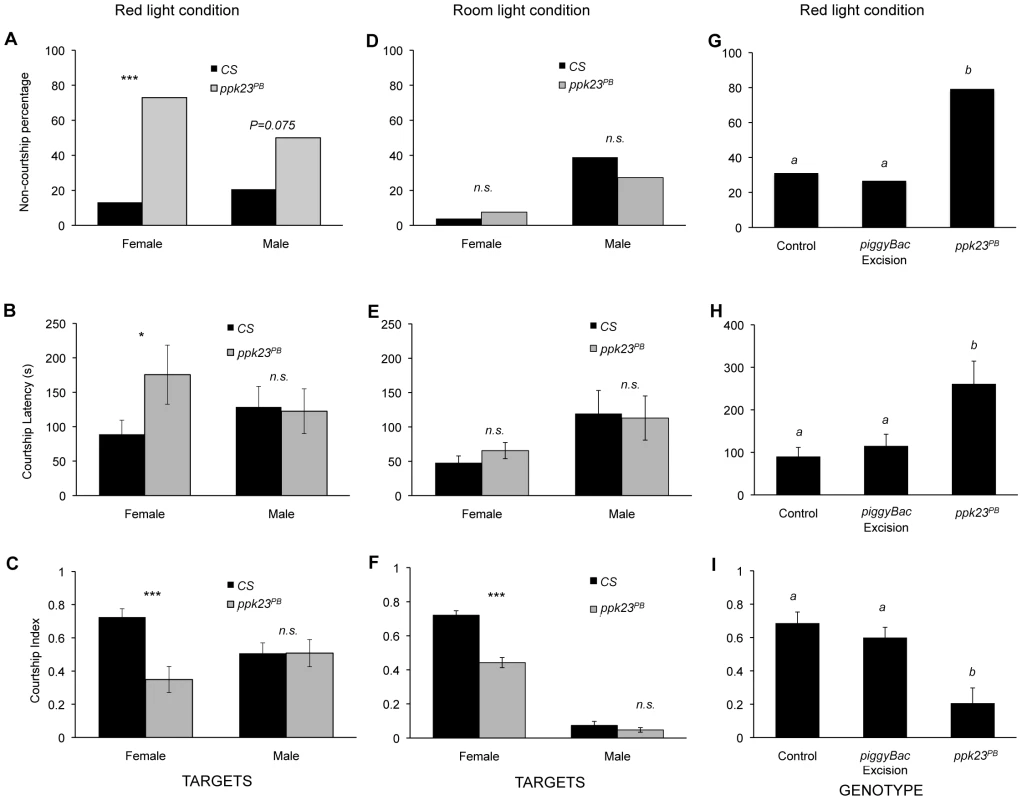
We also tested the courtship responses of ppk23PB mutant flies under normal white (room) light conditions. Under these conditions, more than 90% of the males of both genotypes showed courtship behaviors towards virgin female targets (Figure 5D) without an observable gene effect on courtship latency (Figure 5E). In contrast to latency, ppk23PB mutant flies still exhibited a reduced courtship index in comparison to wild type controls even under room light conditions (Figure 5F). No effects were observed on male-male courtship under these light conditions (Figure 5D–5F). In further support of the specific role of ppk23 in courtship behavior, excision of the ppk23 piggyBac insertion completely reverted the mutant courtship phenotype to wild type levels for both latency and index (Figure 5G–5I).
As additional genetic support for the specific role of ppk23 in male courtship behavior, we utilized recently published complete deletion alleles of ppk23 (Δppk23) and ppk28 (Δppk28) in courtship assays. These deletion lines were generated independently of the ppk23PB allele [31]. In agreement with ppk23PB data, males carrying the null ppk23 allele (Δppk23 in CS background) showed comparable effects with significantly longer courtship latency and reduced courtship index (Figure 6A–6C). In contrast, deletion of the ppk28 locus, a DEG/ENaC subunit that is enriched in gustatory neurons implicated in water sensing in flies [31], [32], had no impact on male courtship behavior (Figure 6A–6C). Furthermore, overexpressing ppk23 cDNA in ppk23-expressing cells was sufficient to rescue the ppk23-induced deficits in courtship index but not courtship latency, which we observed in animals carrying the Δppk23 null allele alone (Figure 6D–6F). Real-time qRT-PCR analyses of ppk23 mRNA expression in the appendages of Δppk23; UAS-ppk23cDNA flies detected low basal ppk23 expression independent of the presence of GAL4 (Figure S2), which may explain the relatively milder phenotype in this background relative to Δppk23 alone. Furthermore, the presence of the mini white marker in the transgenic constructs has been recently shown to increase overall sexual activity of males [33], [34], which may have masked some of the effects of the ppk23 mutation in this background. These data indicate that different DEG/ENaC subunits might contribute to distinct gustatory pathways, some related to feeding and drinking [7], [31], [32], and some to social behaviors.
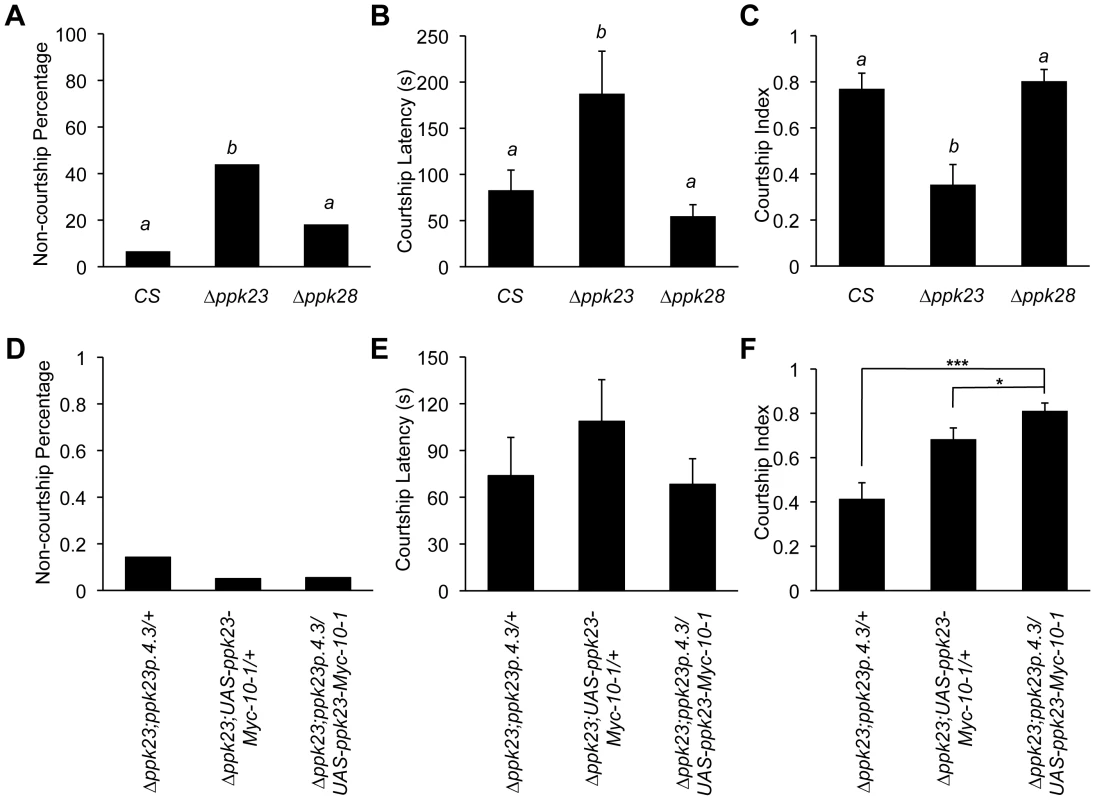
Mutations in ppk23 or manipulations of ppk23-expressing sensory neurons did not lead to any obvious feeding related phenotypes (Figures S3 and S4). These data further supported the specific role of ppk23 in mating behaviors. In addition, neither ppk23PB nor TNT-E-expressing flies showed any obvious developmental or locomotion defects, suggesting the observed courtship phenotype was not due to a general lower activity in males (Figure S5). Furthermore, although males carrying the PiggyBac insertion had reduced overall sexual activity, they were not behaviorally sterile. This was supported by the overall viability of the homozygous ppk23PB and the Δppk23 stocks as well as by directly testing for any obvious behavioral phenotypes in ppk23PB females, which showed normal sexual receptivity to males (Figure S6).
ppk23 plays a role in the response to the female-specific pheromone 7(Z), 11(Z)-Heptacosadiene
Our behavioral and anatomical analyses suggested that ppk23 might be directly involved in the sensory perception of sex pheromones. To test this hypothesis, we examined the effects of a ppk23 mutation on the behavioral responses to 7(Z), 11(Z)-Heptacosadiene (7,11-HD), a female specific aphrodisiac pheromone [35]. We first washed the targets flies (male or female CS flies) three times in hexane to remove as much endogenous pheromone as possible. We then applied 7,11-HD or EtOH alone (the solvent for 7,11-HD). Regardless of the sex of the target, wild type males courted pheromone-laced targets significantly more than ppk23 mutant males as measured by the overall percent courtship (Figure 7A and 7B). We also measured the latency and courtship index of males that initiated courtship of perfumed dummies. As shown in Figure 7C and 7D, there were no significant differences in latency between the two genotypes, which is in agreement with our courtship data of live female targets (Figure 5). In contrast, even when they did initiate courtship, ppk23 mutant males tended to court the dummies with less intensity than wild type males (Figure 7E and 7F). Although these data do not directly address the issue of whether ppk23 is directly involved in sensing the pheromone 7,11-HD they do indicate that sensory detection of at least some pheromones requires the function of DEG/ENaC-dependent signaling.
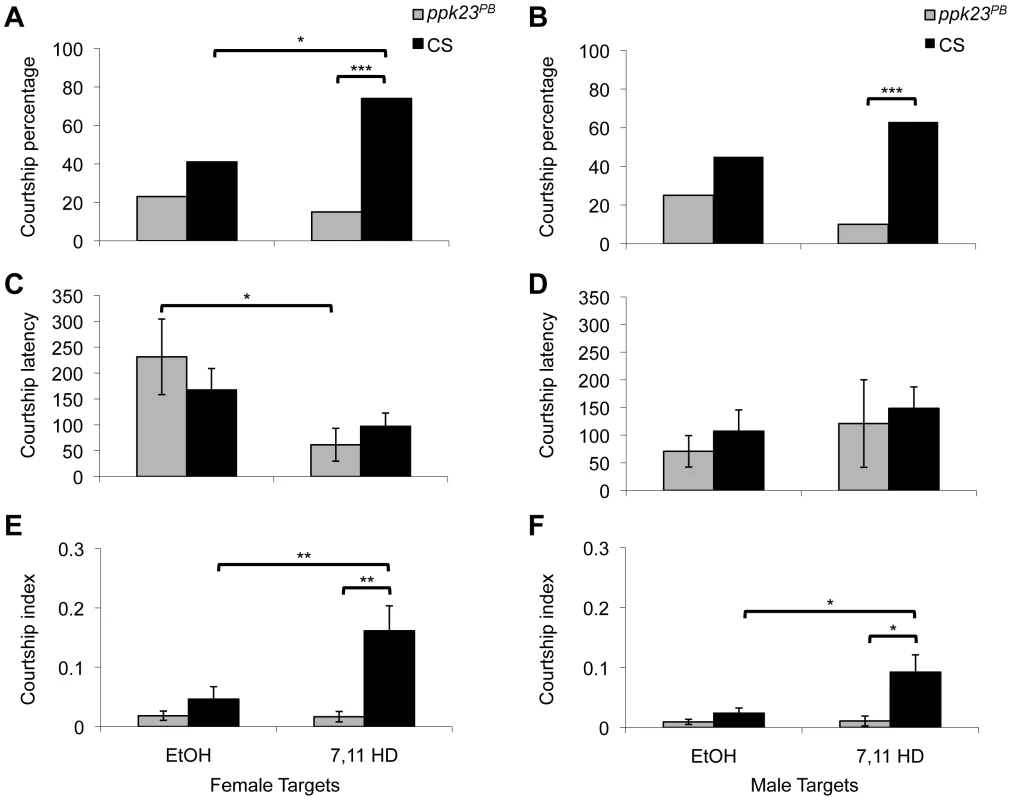
Discussion
Flies behave in a complex chemical environment that includes signals for both feeding and social interactions. How these different signals are sensed and coded by the nervous system is still poorly understood. Our identification of ppk23 expression in chemosensory bristles originally suggested that it might contribute to feeding behaviors. However, we detected no gustatory role for ppk23 or the cells expressing it. Instead, we found that ppk23 contributes to processes underlying male sexual behavior; ppk23 was expressed in sexually dimorphic neurons associated with chemosensory bristles in forelegs, and it was required for normal courtship behavior and attraction to the aphrodisiac pheromone 7,11HD in males.
Several lines of evidence suggest that ppk23 and the cells expressing it are chemosensory. These include the similar morphology of the two neurons that express ppk23 in each chemosensory bristle, which is in contrast to the single distinctive mechanosensory neuron that is present in each chemosensory bristle [22]. Chemosensory functions are also supported by the defective response of ppk23 mutant males to the aphrodisiac pheromone 7,11-HD. However, several recent studies also indicated that DEG/ENaC signaling plays a role in mechanosensory functions in the worm and the fly [36], [37]. Therefore, we currently cannot completely exclude the possibility that ppk23 might also play a role in mechanosensation in the context of mating behavior in flies.
Whether ppk23 is specifically playing a role in courtship behavior or whether it might be important for other types of social behaviors in the fly is still unknown. In support of a more general role for ppk23-dependent signaling in mediating chemically-driven social interactions, a ppk23 mutation was recently identified in a p-elements screen for genes associated with male-male aggression [38]. Together, these data suggest that ppk23-dependent signaling might play a general role in social communications, and may affect the response of flies to diverse social-related chemical signals.
Visual cues play an important role in the initiation of courtship behavior in Drosophila males, and typically will mask deficits in other sensory modalities [20]. Our data support this, indicating that ppk23PB males showed normal courtship latencies under normal lighting conditions. These findings suggest that mutations in ppk23 did not affect the overall sexual drive of males but rather reduced the ability of males to sustain courtship towards female targets in the absence of visual cues, further supporting a chemosensory role for this gene. It also raises an interesting hypothesis; which is that vision (absent under red light condition) is playing a critical role during the initial mate recognition process but is playing a less prominent role in the maintenance of courtship until successful copulation occurs. This is based on our observations that ppk23PB males showed reduced courtship index under both light conditions but exhibited prolonged courtship latencies under red light but not white light conditions. These results indicate that visual inputs were able to overcome chemosensory deficits during the initial orientation towards a female target but were not enough to overcome such deficits for sustaining courtship. Furthermore, our data also indicate that initial chemo-physical contact between the courting male and the female target represents an important trigger for the release of orientation behavior (which was used to determine courtship latency). This may suggest that PPK23 plays a role in triggering male courtship, which was especially robust under red light conditions in which vision is eliminated.
Although we have established ppk23 as a gene important for male sexual behaviors, we do not know whether it plays a similar role in females. Our promoter and expression studies suggested that the locus is expressed in appendages of females. It is possible that ppk23-expressing cells are playing a role that is relevant to intra-species interactions independent of sex. Our female behavioral data suggested that ppk23 mutation did not alter female sexual receptivity, but they do not exclude a possible role in other behaviors.
We still do not know whether ppk23 interacts genetically or physiologically with other receptors previously implicated in Drosophila courtship behaviors. Nevertheless, several lines of investigation already suggest that ppk23 might represent an independent sensory pathway. Typically, gustatory bristles contain either two or four chemosensory neurons, and each expresses a unique set of sensory receptors dedicated to a single taste modality [22]. In contrast, ppk23 was expressed in a pair of chemosensory neurons innervating a single bristle. Of note, our examination of recently published images of the tarsal expression of Gr32a, a chemosensory-related gene involved in inhibiting male-male courtship [39] and the avoidance of aversive chemicals [40], suggests that Gr32a is also expressed in pairs of tarsal chemosensory neurons projecting to single sensory bristles. However, In contrast to ppk23-expressing neurons, which mostly terminate in the thoracic ganglion, many of the tarsal sensory projections of Gr32a-expressing cells form ascending bundles that terminate in the subesophageal ganglion [41], [42]. These data indicate that ppk23 and Gr32a are likely expressed in different sensory neurons, and are playing a role in discrete sensory modalities. This assertion is further supported by previous reports that indicated Gr32a is involved in the inhibition of male-male courtship but not in male-female interactions, while we found that ppk23 plays a role in male-female interactions without any obvious effects on male-male interactions [40], [43]. Other gustatory receptors have also been implicated in courtship behavior. A recent study suggested that Gr39a contributes to the male-female courtship and is required in sustaining courtship behavior [44]. These studies suggest a possible relationship between ppk23 and Gr39a, which is currently under investigation. Finally, our data also support a chemosensory role for ppk7. Since DEG/ENaC channels often function as heteromultimeric protein complexes[45], [46], these data raise the possibility that ppk23 and ppk7 physically interact to form a chemosensory-related channel.
While we do not yet understand the physiological significance of the differences in organization of typical taste-related and ppk23-containing bristles, this separation is analogous to the mammalian chemosensory system, which includes dedicated sensory neurons for pheromonal sensing that are independent of the general chemosensory system [47].
Finding ppk23 expressed in chemosensory neurons and the lack of behavioral responsiveness of ppk23 males to the aphrodisiac pheromone 7,11-HD suggest that PPK23 is a potential candidate for a pheromone receptor, or for a key component of the pheromonal signaling cascade. In summary, our data indicate that DEG/ENaC signaling contributes to sensory functions underlying sex-related behaviors, and indicate a novel physiological function for this important family of ion channels. Finally, the results presented here further support the idea that insects have evolved separate chemosensory systems for appetitive and pheromonal chemosensory signaling.
Materials and Methods
Drosophila stocks and cultures
Flies were maintained on standard cornmeal medium at 25°C under 12:12 light-dark cycle. A ppk23 promoter-GAL4 line was generated by PCR amplifying a 2.6 kb fragment (X: 17402154..17404754), which included the first intron of ppk23 subcloned into an improved pPTGAL4 vector [48]. UAS-ppk23 was generated by cloning the ppk23 ORF from male appendages into a pUASt vector [49]. Transgenic flies were generated according to standard procedures (Rainbow Genetics Inc. Ca). UAS-TNT-E and UAS-IMP-TNT-V1-A were obtained from C. O'Kane (Cambridge, England). UAS-VR1 and the lines expressing three copies of EGFP under direct control of either Gr5a or Gr66a (Gr5a>3xEGFP and Gr66a>3xEGFP, respectively) were from K. Scott (Berkley, CA). Gr5a-GAL4 and Gr66a-GAL4 were from J. Carlson (Yale, CT). The ppk23PB flies were the piggyBac insertion allele of ppk23 (line c03836, Harvard Exelixis collection), which were outcrossed to the Canton-S (CS) background for six generations. We also used piggyBac transposase to remove the piggyBac insertion in the ppk23 locus according to standard genetic method [50]. The Δppk23 and Δppk28 alleles were from the Wang lab [31]. The original published genetic background that carried these alleles had highly reduced overall male courtship behavior likely due to background mutations. Hence, both published alleles were outcrossed into the wild type CS background for six generations prior to the described behavioral studies. Unless mentioned, other fly strains used in our studies were obtained from the Bloomington Stock Center.
RNA analysis
Flies were separated by sex under CO2 and kept at −80°C until processing. To separate body parts, microcentrifuge tubes with flies were dipped in liquid nitrogen and then separated by repeated vortexing. Total RNA from tissues was extracted with the Rneasy mini kit (Qiagen) or Trizol reagent (Invitrogen) according to manufacturer instructions. RT-PCR analysis was performed by using the SuperScript II reverse transcriptase (Invitrogen) with 1 µg total RNA in 20 µl reaction according to manufacturer instructions. PCRs were performed with the ACCUprime pfx supermix (Invitrogen) in 25 µl reactions, and were subsequently separated on a 1.2% agarose gel. Real-time quantitative RT-PCR assays for ppk23 were performed on an “ABI7500 fast” machine with an ABI predesigned probe-based assay (ppk23; Dm01839671_g1) according to manufacturer instructions. For all other assays, gene specific primers were designed with the PrimerExpress package (ABI Inc.) and were analyzed using Power SYBR kit (ABI Inc.). See Table S1 for primer sequences. The housekeeping gene rp49 were used as an RNA loading control (Dm02151827_g1). Data were transformed according to the ΔΔCt method and are represented as relative values [51]. Northern blot analysis was done with the NorthernMax kit (Ambion), using a DIG-labeled ppk23 specific cRNA probe (Roche). The RNA probe was generated via in vitro transcription using a PCR template that included nucleotides 578–1369 of ppk23-RA. The probe was designed to hybridize to all three possible alternatively spliced ppk23 transcripts.
Feeding behavior assay
Groups of 20–30 four to seven day-old flies of mixed sexes were kept overnight in an empty fly vial containing a wet paper towel. On test day, flies were briefly immobilized on ice and then transferred to the test plate. Test plates were 60-well Nunc dishes, which had alternate wells filled with 10 µl of either test compound mixed with 2 mM sucrose or 2 mM sucrose alone (a weak feeding inducer) in 1% agarose. Food dye (1% v/v) was added to each alternative choice (either red or blue). Flies were allowed to feed for 2 h in the dark and were then frozen in a −20°C freezer. Only flies that showed clear dye in their digestive system were further used for index calculation. Choice index was calculated as (# of flies that consumed tested compound + ½ purple [consumed both])/total # of flies that had any dye in their abdomen. Choice index of 0.5 indicated that the consumption of the tested compound was not different than 2 mM sucrose. Any deviation towards index of 1 or 0 reflected a positive or negative preference, respectively of the compound relative to 2 mM sucrose. Concentrations for various compounds are in figure legends, except for in Figure 3D; yeast was 0.16% v/v live Baker's yeast paste. E. coli (DH5α strain) was 10% v/v overnight culture in standard LB medium. “Old food” was 10% v/v one-week-old standard Drosophila culture food from a high-density population. Monosodium glutamate (MSG) was 30 mM. Bovine serum albumin (BSA) was 2% w/v. No obvious differences between males and females were observed in our assays. Consequently, data were collected from mixed sex assays.
Proboscis extension response
Proboscis extension was assayed in 2 day old males as previously described [17] with the following modifications. 1 d old flies were starved for approximately 24 hours, then immobilized by chilling on ice and mounted ventral-side-up using myristic acid. Flies were allowed to recover for two hours in humid conditions. To begin the experiment, flies were satiated with water until no proboscis extension was elicited by water stimulation. Next, flies were tested by touching a drop of a solution on a pipette tip to a foreleg and scored for full proboscis extension. Flies were given three trials of same substance in each concentration with water application in-between trials; only flies that responded at least 2 out of 3 times were considered ‘responders’ for that concentration. For bitter assays, 100 mM sucrose was included at all concentrations of caffeine. At the beginning and the end of each assay, flies were tested for response to 100 mM sucrose and any fly failing to respond was excluded from the study. The “percent responders” for each genotype at each concentration was calculated by tallying the number of flies responding divided by the total number of flies tested. The responding index represents the cumulative scores (sum of all responses of an individual animal to a specific sequence of tarsal stimuli).
Courtship behavior
Courtship behavior was assayed with four to seven day old males as previously described [17] with the following modifications. Newly emerged males were kept in individual vials with food until tested. Courtship assays were done under the red light conditions unless differently stated and the targets were the decapitated flies. Courtship latency was calculated as the time from female introduction until the male showed obvious courtship behavior such as orientation coupled with wing extensions. In wild type males, first orientation was typically concurrent with first contact with a female. In all cases when we observed a delayed latency, the initiation of courtship required multiple contacts between males and females. Males were observed for 10 min. Once courtship began, courtship index was calculated as the proportion of time a male spent in any courtship-related activity during a 10 min period or until mating occurred. For the 7,11-HD experiments, all the targets used were virgin 5 days old flies and freshly cleaned the cuticle hydrocarbon by 3 times 5-min hexane washes, then were applied 2.5 ul of 50 ng/ul 7,11-HD or the control solvent, 100% ethanol. All assays were performed under normal light conditions in circular courtship arenas, 22 mm in diameter. Tests for general locomotion were performed as previously described [52], [53].
Statistical procedures
All statistical tests were performed using the R statistical package. Data were tested for normality by using the Shapiro-Wilk test. Two-sample t-tests and one-way ANOVA tests were used for parametric statistics and the two-samples wilcoxon test and Kruskal-Wallis rank sum test were used for non-parametric tests. Chi-square tests were used for examining frequency-based data.
Supporting Information
Zdroje
1. VoetsTTalaveraKOwsianikGNiliusB 2005 Sensing with TRP channels. Nat Chem Biol 1 85 92
2. SatoKPellegrinoMNakagawaTVosshallLBTouharaK 2008 Insect olfactory receptors are heteromeric ligand-gated ion channels. Nature 452 1002 1006
3. WicherDSchaferRBauernfeindRStensmyrMCHellerR 2008 Drosophila odorant receptors are both ligand-gated and cyclic-nucleotide-activated cation channels. Nature 452 1007 1011
4. BentonRVanniceKSGomez-DiazCVosshallLB 2009 Variant Ionotropic Glutamate Receptors as Chemosensory Receptors in Drosophila. Cell 136 149 162
5. WemmieJAPriceMPWelshMJ 2006 Acid-sensing ion channels: advances, questions and therapeutic opportunities. Trends in Neurosciences 29 578 586
6. LinguegliaEChampignyGLazdunskiMBarbryP 1995 Cloning of the amiloride-sensitive FMRFamide peptide-gated sodium channel. Nature 378 730 733
7. LiuLLeonardASMottoDGFellerMAPriceMP 2003 Contribution of Drosophila DEG/ENaC genes to salt taste. Neuron 39 133 146
8. ChandrashekarJKuhnCOkaYYarmolinskyDAHummlerE 2010 The cells and peripheral representation of sodium taste in mice. Nature 464 297 301
9. O'HaganRChalfieMGoodmanMB 2005 The MEC-4 DEG/ENaC channel of Caenorhabditis elegans touch receptor neurons transduces mechanical signals. Nat Neurosci 8 43 50
10. PriceMPMcIlwrathSLXieJChengCQiaoJ 2001 The DRASIC cation channel contributes to the detection of cutaneous touch and acid stimuli in mice. Neuron 32 1071 1083
11. ConsortiumHGS 2006 Insights into social insects from the genome of the honeybee Apis mellifera. Nature 443 931 949
12. VervoortMZinkDPujolNVictoirKDumontN 1995 Genetic determinants of sense organ identity in Drosophila: regulatory interactions between cut and poxn. Development 121 3111 3120
13. NottebohmEUsuiATherianosSKimuraKDambly-ChaudiereC 1994 The gene poxn controls different steps of the formation of chemosensory organs in Drosophila. Neuron 12 25 34
14. Dambly-ChaudiereCJametEBurriMBoppDBaslerK 1992 The paired box gene pox neuro: a determinant of poly-innervated sense organs in Drosophila. Cell 69 159 172
15. LiuLJohnsonWAWelshMJ 2003 Drosophila DEG/ENaC pickpocket genes are expressed in the tracheal system, where they may be involved in liquid clearance. Proc Natl Acad Sci U S A 100 2128 2133
16. Ben-ShaharYNannapaneniKCasavantTLScheetzTEWelshMJ 2007 Eukaryotic operon-like transcription of functionally related genes in Drosophila. Proc Natl Acad Sci U S A 104 222 227
17. Ben-ShaharYLuBCollierDMSnyderPMSchnizlerM 2010 The Drosophila gene CheB42a is a novel modifier of Deg/ENaC channel function. PLoS ONE 5 e9395 doi:10.1371/journal.pone.0009395
18. LinHMannKJStarostinaEKinserRDPikielnyCW 2005 A Drosophila DEG/ENaC channel subunit is required for male response to female pheromones. Proc Natl Acad Sci U S A 102 12831 12836
19. BrandAHPerrimonN 1993 Targeted gene expression as a means of altering cell fates and generating dominant phenotypes. Development 118 401 415
20. EjimaAGriffithLC 2007 Measurement of Courtship Behavior in Drosophila melanogaster. Cold Spring Harb Protoc 2007 pdb.prot4847-
21. AwasakiTKimuraK 1997 pox-neuro is required for development of chemosensory bristles in Drosophila. J Neurobiol 32 707 721
22. VosshallLBStockerRF 2007 Molecular architecture of smell and taste in Drosophila. Annu Rev Neurosci 30 505 533
23. AmreinH 2004 Pheromone perception and behavior in Drosophila. Curr Opin Neurobiol 14 435 442
24. DemirEDicksonBJ 2005 fruitless splicing specifies male courtship behavior in Drosophila. Cell 121 785 794
25. ManoliDSFossMVillellaATaylorBJHallJC 2005 Male-specific fruitless specifies the neural substrates of Drosophila courtship behaviour. Nature 436 395 400
26. MellertDJKnappJMManoliDSMeissnerGWBakerBS 2010 Midline crossing by gustatory receptor neuron axons is regulated by fruitless, doublesex and the Roundabout receptors. Development 137 323 332
27. YuJYKanaiMIDemirEJefferisGSDicksonBJ 2010 Cellular organization of the neural circuit that drives Drosophila courtship behavior. Curr Biol 20 1602 1614
28. SiwickiKKKravitzEA 2009 Fruitless, doublesex and the genetics of social behavior in Drosophila melanogaster. Curr Opin Neurobiol 19 200 206
29. StockingerPKvitsianiDRotkopfSTirianLDicksonBJ 2005 Neural circuitry that governs Drosophila male courtship behavior. Cell 121 795 807
30. MarellaSFischlerWKongPAsgarianSRueckertE 2006 Imaging Taste Responses in the Fly Brain Reveals a Functional Map of Taste Category and Behavior. Neuron 49 285 295
31. ChenZWangQWangZ 2010 The amiloride-sensitive epithelial Na+ channel PPK28 is essential for drosophila gustatory water reception. J Neurosci 30 6247 6252
32. CameronPHiroiMNgaiJScottK 2010 The molecular basis for water taste in Drosophila. Nature 465 91 95
33. AnakaMMacDonaldCDBarkovaESimonKRostomR 2008 The white gene of Drosophila melanogaster encodes a protein with a role in courtship behavior. J Neurogenet 22 243 276
34. HingALCarlsonJR 1996 Male-male courtship behavior induced by ectopic expression of the Drosophila white gene: role of sensory function and age. J Neurobiol 30 454 464
35. AntonyCDavisTLCarlsonDAPechineJMJallonJM 1985 Compared Behavioral-Responses of Male Drosophila-Melanogaster (Canton-S) to Natural and Synthetic Aphrodisiacs. Journal of Chemical Ecology 11 1617 1629
36. GeffeneySLCuevaJGGlauserDADollJCLeeTHC 2011 DEG/ENaC but Not TRP Channels Are the Major Mechanoelectrical Transduction Channels in a C. elegans Nociceptor. Neuron 71 845 857
37. ZhongLHwangRYTraceyWD 2010 Pickpocket is a DEG/ENaC protein required for mechanical nociception in Drosophila larvae. Curr Biol 20 429 434
38. EdwardsACZwartsLYamamotoACallaertsPMackayTF 2009 Mutations in many genes affect aggressive behavior in Drosophila melanogaster. BMC Biol 7 29
39. MiyamotoTAmreinH 2008 Suppression of male courtship by a Drosophila pheromone receptor. Nat Neurosci 11 874 876
40. LeeYKimSHMontellC 2010 Avoiding DEET through insect gustatory receptors. Neuron 67 555 561
41. KoganezawaMHabaDMatsuoTYamamotoD 2010 The shaping of male courtship posture by lateralized gustatory inputs to male-specific interneurons. Curr Biol 20 1 8
42. NojimaTKimuraKKoganezawaMYamamotoD 2010 Neuronal synaptic outputs determine the sexual fate of postsynaptic targets. Curr Biol 20 836 840
43. MoonSJLeeYJiaoYMontellC 2009 A Drosophila gustatory receptor essential for aversive taste and inhibiting male-to-male courtship. Curr Biol 19 1623 1627
44. WatanabeKTobaGKoganezawaMYamamotoD 2011 Gr39a, a highly diversified gustatory receptor in Drosophila, has a role in sexual behavior. Behav Genet 41 746 753
45. BensonCJXieJWemmieJAPriceMPHenssJM 2002 Heteromultimers of DEG/ENaC subunits form H+-gated channels in mouse sensory neurons. Proc Natl Acad Sci U S A 99 2338 2343
46. EskandariSSnyderPMKremanMZampighiGAWelshMJ 1999 Number of Subunits Comprising the Epithelial Sodium Channel. J Biol Chem 274 27281 27286
47. BrennanPAZufallF 2006 Pheromonal communication in vertebrates. Nature 444 308 315
48. SharmaYCheungULarsenEWEberlDF 2002 PPTGAL, a convenient Gal4 P-element vector for testing expression of enhancer fragments in drosophila. Genesis 34 115 118
49. PhelpsCBBrandAH 1998 Ectopic Gene Expression in Drosophila Using GAL4 System. Methods 14 367 379
50. ThibaultSTSingerMAMiyazakiWYMilashBDompeNA 2004 A complementary transposon tool kit for Drosophila melanogaster using P and piggyBac. Nat Genet 36 283 287
51. Ben-ShaharYRobichonASokolowskiMBRobinsonGE 2002 Influence of gene action across different time scales on behavior. Science 296 741 744
52. SunYLiuLBen-ShaharYJacobsJSEberlDF 2009 TRPA channels distinguish gravity sensing from hearing in Johnston's organ. Proc Natl Acad Sci U S A 106 13606 13611
53. VillellaAGaileyDABerwaldBOhshimaSBarnesPT 1997 Extended reproductive roles of the fruitless gene in Drosophila melanogaster revealed by behavioral analysis of new fru mutants. Genetics 147 1107 1130
54. BollWNollM 2002 The Drosophila Pox neuro gene: control of male courtship behavior and fertility as revealed by a complete dissection of all enhancers. Development 129 5667 5681
55. XuAParkSKD'MelloSKimEWangQ 2002 Novel genes expressed in subsets of chemosensory sensilla on the front legs of male Drosophila melanogaster. Cell Tissue Res 307 381 392
56. FischlerWKongPMarellaSScottK 2007 The detection of carbonation by the Drosophila gustatory system. Nature 448 1054 1057
Štítky
Genetika Reprodukčná medicínaČlánok vyšiel v časopise
PLOS Genetics
2012 Číslo 3
- Je „freeze-all“ pro všechny? Odborníci na fertilitu diskutovali na virtuálním summitu
- Gynekologové a odborníci na reprodukční medicínu se sejdou na prvním virtuálním summitu
Najčítanejšie v tomto čísle
- PIF4–Mediated Activation of Expression Integrates Temperature into the Auxin Pathway in Regulating Hypocotyl Growth
- Metabolic Profiling of a Mapping Population Exposes New Insights in the Regulation of Seed Metabolism and Seed, Fruit, and Plant Relations
- A Splice Site Variant in the Bovine Gene Compromises Growth and Regulation of the Inflammatory Response
- Comprehensive Research Synopsis and Systematic Meta-Analyses in Parkinson's Disease Genetics: The PDGene Database
